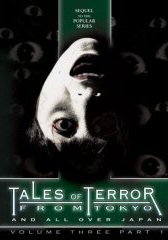
The Asian ghost story continues to scare in audiences, disturbing and titillating with equal aplomb (and varying degrees of box office success). These films appeal to both the child in us afraid of the dark and the complex adult struggling with questions or morality, mortality, and the unknown. They evoke raw emotion through a careful blend of myth and magic, realism and fantasy, digging deep into our subconscious by existing just on the outside of the commonplace, so very chilling because their elements of the supernatural are so closely related to the everyday world we live in but don't know half as well as we pretend. Tales of Terror from Tokyo 3 (Part One) is quick to capitalize off these truisms, and does so with a style and simplicity both endearing and satisfying. A worthy follow up to its predecessors, merging simplistic "Boo!' frights with solid characterizations and a moody ambience that makes the nightmarishly impossible believable, this series maintains the simple pleasures of campfire storytelling in an urban environment. If nothing else, these enjoyable (if occasionally weakly structured) stories reaffirm the pertinence of the traditional ghost story as it applies to culture, art, and the individual. The best of them challenge us by making us face our upcoming mortality. Descending into macabre possibilities of what the after-life may hold and the generally weird, this newest anthology from Media Blasters explores the spectral depths of our cultural fears with effectively paced scares.
"Just because the gates to the spirit world are usually kept shut does not mean that they cannot suddenly open, that the dead cannot reach out for your throat, that its denizens cannot prowl in abandoned office buildings, or haunt high school video projects." This descriptive passage, slapped on the packaging of this disc, summarizes the basic approach of these stories, which include as highlights "The Red Eyes," directed by Kosuke Suzuki, "My Wife's Coming," by Noboru Iguchi, and "Shadows Setting By Their Feet," again by Iguchi. These thirteen vignettes set out to frighten through quick, jarring shots, sleek editing, and the use of the viewer's own inner eye. They also revitalize traditional themes and folklore, transplanting them in contemporary environments and situations, with characters who are believable (if not always sympathetic). In the world these shorts depict, the occult is only a heartbeat away, with the supernatural right on the periphery of our vision. Not only ghosts but deep rooted guilt and desires haunt these characters.
As entertaining as these short-shorts are, displaying a simplistic yet satisfying immediacy and intimacy due to the immediate understanding/empathy that these situations evoke, there is more than shock to be had. In fact, in the best Asian ghost story tradition, there is a conscience absence of gore or violence, with suggestion, character, and mood all taking president. Thankfully, the approach of the directors/writers are fresh enough -- and submerged to such a degree in atmosphere -- that the somewhat overused subtlety of the 'supernatural' style is kept from becoming trite. Atmosphere plays a crucial role, and the direction is professional if not inspired. The characters, although depicted for only a brief time, are surrounded by darkness also within them, each casting out their sorrows and desires, fears and apprehensions to the outside world . . . and in these instances, the darkness answers . . .
Writers Kihara Hirokatsu and Nakayama Ichiro find fresh, disturbing faces to represent the uncanny threats that challenge, plague, and fascinate us. Tales Of Terror From Tokyo 3 titillates with its 'spook show' surface mentality even while it subverts accepted views of reality, whipping away cultural security blankets. The film gets under our skin in a limited amount of time. Time remains in issue, just as it was in earlier versions of the franchise. Not only characterization is limited but so is plot development. In fact, these aren't plots in the traditional sense of the word, but flashes of insight -- of meta fiction -- that leave a greater impression than they should through strong imagery and careful event selection. The lack of fully developed plots actually works in their favor, lending a further ambience of mystery and enigma. Similar to nightmares, which carry their own sense of logic, such pieces as "Ghost House" and "Red Tricycle" subvert reality as much in form as in theme. All in all, this compilation will give you an uneasy evening, and have you looking behind the sofa for things better left buried . . .
Media Blaster's transfer is offered in 1.85:1, and the visual elements look clean and free from distortion. Images are a little soft at times, but nothing dramatic. Grain is absent. Colors are satisfyingly life-like when not emphasized for atmosphere. Audio is in Dolby Digital, featuring the original Japanese with additional English Subs. The only extras are trailers for other Tokyo Shock features.
Review by William P. Simmons
| Released by Tokyo Shock |
| Region 1 - NTSC |
| Not Rated |
| Extras : |
| see main review |